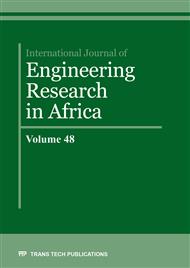[1]
A.F. Owa, I.O. Oladele, O.G. Agabiaka and J.A. Omotoyinbo (2018): Milk Bush (Thevetia peruviana) Seed Oil as Feed Stock for Bio-polymer Production. Annals of Faculty Engineering Hunedoara-International Journal of Engineering, 26 (4), 201-204.
Google Scholar
[2]
S.A. Ibiyemi S.A., V.O. Fadipe, O.O. Akinremi, S.S. Bako [2002]: Variation in oil composition of Thevetia peruviana Juss (Yellow Oleander) fruits seeds, J. Appl. Sci. Environ. Mgt. (JASEM), 6 (2), 61 – 65.
DOI: 10.4314/jasem.v6i2.17178
Google Scholar
[3]
N.K. Sahoo, R.C. Subhalaxmi Pradhamn, S.N. Pradhan Naik. (2009.): Physical Properties of Fruit and Kernel of Thevetia peruviana J. a potential biofuel plant, Int. Agrophysis, 23, 199.
Google Scholar
[4]
A. Gandini (2008): Polymers from Renewable Resources: A Challenge for the Future of Macromolecular Materials. Macromolecules, 41, 9491.
DOI: 10.1021/ma801735u
Google Scholar
[5]
U. Biermann, U. Bornscheuer, M. A. R. Meier, J. O. Metzger, H.J. Schäfer (2011): Oils and Fats as Renewable Raw Materials in Chemistry. Angewandte Chem. Int. Edu. 50, 3854.
DOI: 10.1002/anie.201002767
Google Scholar
[6]
C.O. Akintayo, H. Mutlu, M. Kempf, M. Wilhem, and M. A. R. Meier (2012): Acyclic Triene Metathesis Polymerization of Plukenetia Conophora Oil: Branched Polymers by Direct Polymerization of Renewable Resources. Macromolecular Chemistry and Physics, 213, 87-96.
DOI: 10.1002/macp.201100539
Google Scholar
[7]
J. O. Metzger and U. Bornscheuer (2006): Lipids as Renewable Resources: Current State of Chemical and Biotechnological Conversion and Diversification. Applied Microbiology and Biotechnology, 71, 13.
DOI: 10.1007/s00253-006-0335-4
Google Scholar
[8]
C. Wang and F. N. Jones (2000): Stability and Film Properties of Tung Oil Modified Soybean Alkyd Emulsion. Journal of Applied Polymer Science, 78, 1698.
DOI: 10.1002/1097-4628(20001128)78:9<1698::aid-app160>3.0.co;2-j
Google Scholar
[9]
S. Ahmad, S. M. Ashraf. Naqvi, S. Yadav, A. Hasnat. (2003): A Polyestermide from Pongamia Glabra Oil for Biological Safe Anticorrosive Coating. Progress in Organic Coating. 42, 95.
DOI: 10.1016/s0300-9440(03)00015-8
Google Scholar
[10]
S. Ahamad, G. Imran, S. A. Ahmad, A. Hasnat. (2015): Synthesis and Characterization of Polyesteramide Urethane Derived from Melia Azedarach Seed Oil. Oriental Journal of Chemistry. 31, 2, pp.1169-1173.
DOI: 10.13005/ojc/310271
Google Scholar
[11]
S. Ahmad, S.M. Ashraf, F.Zafar. (2007): Development of Linseed Oil Based Polyetermide Without Organic Solvent at Lower Temperature. Journal of Applied Polymer. 104, 1143-1148.
DOI: 10.1002/app.25774
Google Scholar
[12]
J. John, M. Bhattacharya, R. B. Turner. (2002): Characterization of Polyurethane Foams from Soybean Oil. Journal of Applied Polymer Science. 86, 3097.
DOI: 10.1002/app.11322
Google Scholar
[13]
E. Can, S. Küsefoğlu, R. P. Wool. (2001): Rigid, Thermosetting Liquid Molding Resins from Renewable Resources. I. Synthesis and Polymerization of Soy Oil Monoglyceride Maleates. Journal of Applied Polymer Science, vol. 81, 69-77.
DOI: 10.1002/app.1414
Google Scholar
[14]
W.J. Lee, C. L. Kang, and K. C. Chang (2011): Synthesis and Properties of Resole-type Phenol-formaldehyde Resins Prepared from H2SO4- and HCl-catalyzed Phenol-liquefied Cryptomeria Japonica Wood. Holzfors; 66: 67.
DOI: 10.1515/hf.2011.121
Google Scholar
[15]
D. D. Andjelkovic, M. Valverde, P. Henna, F. Li and R. C. Larock (2005): Novel Thermosets Prepared by Cationic Copolymerization of Various Vegetable Oils – Synthesis and their Structure – Property Relationship. Polymer, 46, 9674-9685.
DOI: 10.1016/j.polymer.2005.08.022
Google Scholar
[16]
L.H. Sparling (2001): Introduction to Physical Polymer Science. 3rd Edition, Wiley, New York.
Google Scholar
[17]
M. Zhan, and R. P. Wool (2010): Biobased Composites Resins Design for Electronic Materials. Applied Polymer Science, 118:3274-3283.
DOI: 10.1002/app.32633
Google Scholar
[18]
L. A. Pothan, Z. Oommen, and S. Thomas (2003) Dynamic Mechanical Analysis of Banana Fiber Reinforced Polyester Composites. Composites Science and Technology, 63: 283-293.
DOI: 10.1016/s0266-3538(02)00254-3
Google Scholar
[19]
K. H. Chang, and R. P. Wool. (2005): Development of a Bio-Based Composite Material from Soybean Oil and Keratin Fibres, Journal of Applied Polymer Science, Vol.95, Pp1524-1538.
DOI: 10.1002/app.21044
Google Scholar
[20]
G. Levita, S. De Pettis, A. Marchetti and A. Lazzeri (1991): Crosslink Density and Fracture Toughness of Epoxy Resins. Journal of Materials Science 26(9) 2348-2352. DOI://doi.org/10.1007/BFO1130180.
DOI: 10.1007/bf01130180
Google Scholar
[21]
Xiao-Feng Liu, Xi Luo, Bo-Wen Liu, Hai-Yi Zhorg, De-Ming Guo, Rong Yang, Li Cheng, Yu-Zhong Wang (2019): Toughening Epoxy Resin using a Liquid Crystalline Elastomer for Versatile Application. ACS Applied Polymer Materials, 1(9), 2291-2301.
DOI: 10.1021/acsapm.9b00319
Google Scholar


